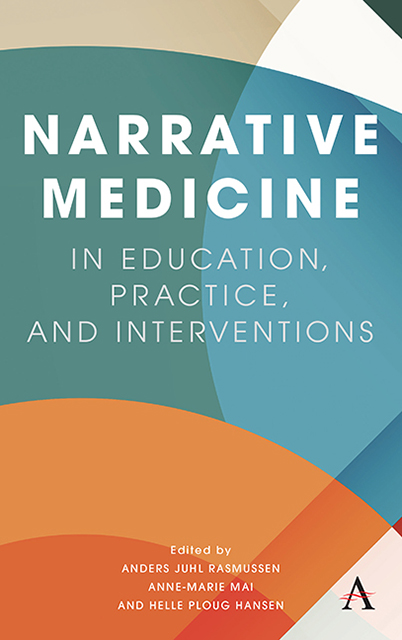57 results
OP30 Model for ASsessing The Value Of AI In Medical Imaging (MAS-AI)
-
- Journal:
- International Journal of Technology Assessment in Health Care / Volume 38 / Issue S1 / December 2022
- Published online by Cambridge University Press:
- 23 December 2022, p. S12
-
- Article
-
- You have access
- Export citation
Introduction
-
-
- Book:
- Narrative Medicine in Education, Practice, and Interventions
- Published by:
- Anthem Press
- Published online:
- 08 June 2023
- Print publication:
- 01 November 2022, pp 13-22
-
- Chapter
- Export citation
Contents
-
- Book:
- Narrative Medicine in Education, Practice, and Interventions
- Published by:
- Anthem Press
- Published online:
- 08 June 2023
- Print publication:
- 01 November 2022, pp 5-6
-
- Chapter
- Export citation
Author biographies
-
- Book:
- Narrative Medicine in Education, Practice, and Interventions
- Published by:
- Anthem Press
- Published online:
- 08 June 2023
- Print publication:
- 01 November 2022, pp 187-190
-
- Chapter
- Export citation
Narrative Medicine in Healthcare Education
-
- Book:
- Narrative Medicine in Education, Practice, and Interventions
- Published by:
- Anthem Press
- Published online:
- 08 June 2023
- Print publication:
- 01 November 2022, pp 65-66
-
- Chapter
- Export citation
Register
-
- Book:
- Narrative Medicine in Education, Practice, and Interventions
- Published by:
- Anthem Press
- Published online:
- 08 June 2023
- Print publication:
- 01 November 2022, pp 191-193
-
- Chapter
- Export citation
Narratives in Medicine
-
- Book:
- Narrative Medicine in Education, Practice, and Interventions
- Published by:
- Anthem Press
- Published online:
- 08 June 2023
- Print publication:
- 01 November 2022, pp 23-24
-
- Chapter
- Export citation
Frontmatter
-
- Book:
- Narrative Medicine in Education, Practice, and Interventions
- Published by:
- Anthem Press
- Published online:
- 08 June 2023
- Print publication:
- 01 November 2022, pp 1-4
-
- Chapter
- Export citation
Narrative Medicine in Interventions
-
- Book:
- Narrative Medicine in Education, Practice, and Interventions
- Published by:
- Anthem Press
- Published online:
- 08 June 2023
- Print publication:
- 01 November 2022, pp 135-136
-
- Chapter
- Export citation

Narrative Medicine in Education, Practice, and Interventions
-
- Published by:
- Anthem Press
- Published online:
- 08 June 2023
- Print publication:
- 01 November 2022
Narratives in Healthcare Practice
-
- Book:
- Narrative Medicine in Education, Practice, and Interventions
- Published by:
- Anthem Press
- Published online:
- 08 June 2023
- Print publication:
- 01 November 2022, pp 101-102
-
- Chapter
- Export citation
Model for ASsessing the value of Artificial Intelligence in medical imaging (MAS-AI)
- Part of
-
- Journal:
- International Journal of Technology Assessment in Health Care / Volume 38 / Issue 1 / 2022
- Published online by Cambridge University Press:
- 03 October 2022, e74
-
- Article
- Export citation
(Inequality in) Interest Group Involvement and the Legitimacy of Policy Making
-
- Journal:
- British Journal of Political Science / Volume 53 / Issue 1 / January 2023
- Published online by Cambridge University Press:
- 08 July 2022, pp. 45-64
- Print publication:
- January 2023
-
- Article
-
- You have access
- Open access
- HTML
- Export citation
Party government and policy responsiveness. Evidence from three parliamentary democracies
-
- Journal:
- Journal of Public Policy / Volume 40 / Issue 2 / June 2020
- Published online by Cambridge University Press:
- 19 November 2018, pp. 329-347
-
- Article
-
- You have access
- Open access
- HTML
- Export citation
Babies and Books: The Holy Kinship as a Way of Thinking About Women's Power in Late Medieval Northern Europe
- from Part IV - Female Authority: Networks and Influence
-
-
- Book:
- Founding Feminisms in Medieval Studies
- Published by:
- Boydell & Brewer
- Published online:
- 05 July 2016
- Print publication:
- 17 March 2016, pp 205-218
-
- Chapter
- Export citation
Negotiating the Personal and Professional: Ethnomusicologistsl and Uncomfortable Truths
-
- Journal:
- Yearbook for Traditional Music / Volume 48 / 2016
- Published online by Cambridge University Press:
- 06 December 2018, pp. 186-203
- Print publication:
- 2016
-
- Article
- Export citation
Lunch frequency among adolescents: associations with sociodemographic factors and school characteristics
-
- Journal:
- Public Health Nutrition / Volume 19 / Issue 5 / April 2016
- Published online by Cambridge University Press:
- 20 May 2015, pp. 872-884
-
- Article
-
- You have access
- HTML
- Export citation
Biased access? Exploring selection to advisory committees
-
- Journal:
- European Political Science Review / Volume 7 / Issue 3 / August 2015
- Published online by Cambridge University Press:
- 13 November 2014, pp. 343-372
-
- Article
- Export citation
Iodine excretion has decreased in Denmark between 2004 and 2010 – the importance of iodine content in milk
-
- Journal:
- British Journal of Nutrition / Volume 112 / Issue 12 / 28 December 2014
- Published online by Cambridge University Press:
- 30 October 2014, pp. 1993-2001
- Print publication:
- 28 December 2014
-
- Article
-
- You have access
- HTML
- Export citation
Transforming European Law: The Establishment of the Constitutional Discourse from 1950 to 1993
-
- Journal:
- European Constitutional Law Review / Volume 10 / Issue 2 / September 2014
- Published online by Cambridge University Press:
- 14 August 2014, pp. 199-225
- Print publication:
- September 2014
-
- Article
- Export citation



